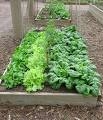Planning A Raised Bed Vegetable Garden
Raised bed gardening has a huge following of gardeners, and every year more and more people are converted to this idea of gardening. There are many reasons for this. One big reason is that raised bed gardens are more easily incorporated into an overall landscape theme. Due to the fact they are raised off the ground, and generally only have one or at most two types of vegetables growing in them raised bed gardens have a much neater appearance than regular gardens. Raised beds can be built to any size and configuration to fit a particular space. Raised beds can be made out of a wide variety of materials. The most common materials used in raised bed gardening are cedar wood, willow reeds, bamboo and log. The dirt in a raised bed garden will become warmer earlier in the spring so you can start some of your seeds earlier than in a conventional garden. You can produce a much larger yield of vegetables with raised bed gardening then with conventional gardening. With conventional gardening you need to have rows between the furrows of vegetables that are wide enough to be walked through, and wide enough to accommodate a cultivator or other gardening tools. Most gardeners make their raised bed gardens long enough and wide enough so that the entire garden can be worked easily from each of the sides, no more bending and stooping to work in the garden! This makes raised bed gardening especially appealing to older gardeners and seniors who may not be as flexible. Raised garden beds are usually 6 to 8 inches off the ground. You should choose the site for raised bed gardening exactly as you would for a conventional garden. If you don't have a spot available that gets full sun you'll need an area that gets at least a half of day of sunlight, afternoon sunlight is usually best. Another advantage of raised bed gardening is the ability to have the exact type of soil you want without having to deal with lousy soil. In some areas of the country clay is the norm, and in some areas it's sand. Generally any soil you come across in your lawn needs to be amended to support gardening. In your raised bed garden you can use a simple mix of topsoil and organic matter of your choice. As with a conventional garden you'll want to carefully plan out the use of your raised bed garden. Group vegetables together based on maturing time. Practice succession planting. When one crop finishes you should be able to start another crop. |
